How Slow Feeder Dog Bowls Help Prevent Bloat in Dogs
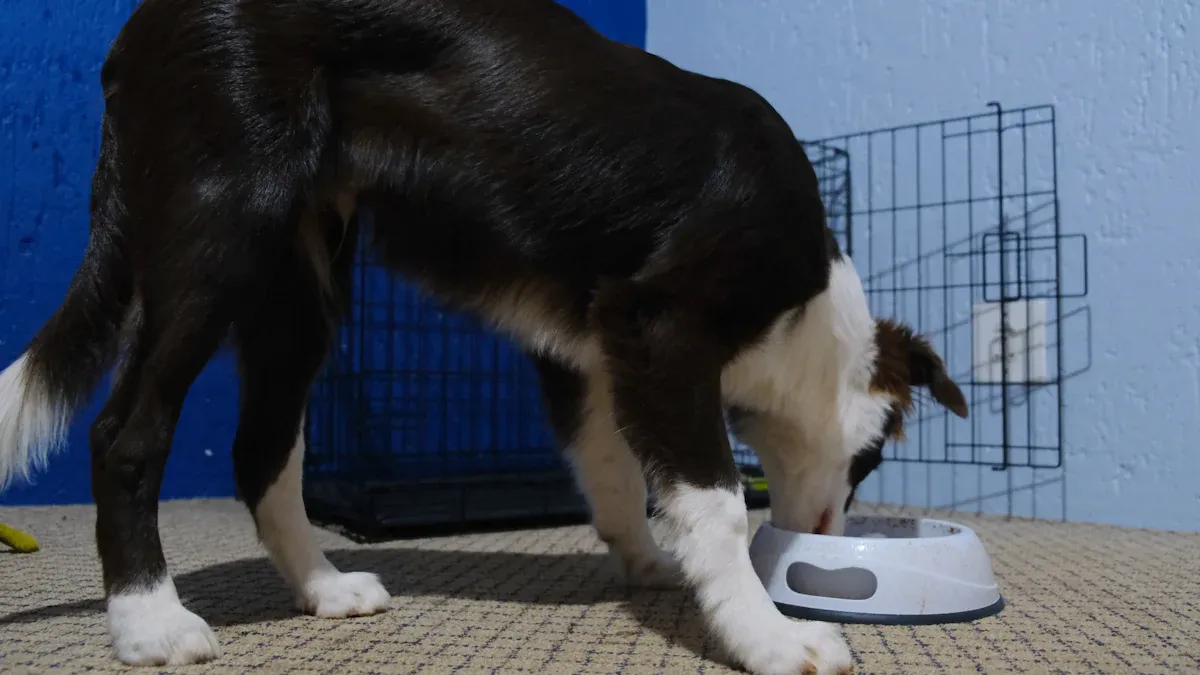
A slow feeder dog bowl can improve your dog’s health. It makes them eat slower, which helps stop dog bloat. Bloat is a serious problem that affects digestion. Eating too fast makes dogs swallow extra air. This can cause pain or even serious health problems. Eating slower reduces these risks and helps with digestion. These bowls also teach better eating habits. They make mealtime safer and more fun for your dog.
Key Takeaways
-
Slow feeder bowls make dogs eat slower, lowering the chance of bloat from gulping air.
-
Eating slowly helps digestion and lets dogs get more nutrients.
-
Slow feeder bowls make meals more fun and engaging for dogs.
-
Picking the right bowl for your dog's size and habits is important.
-
Using slow feeder bowls often encourages healthy eating and prevents weight gain.
Understanding Bloat in Dogs
What Is Gastric Dilatation-Volvulus (GDV)?
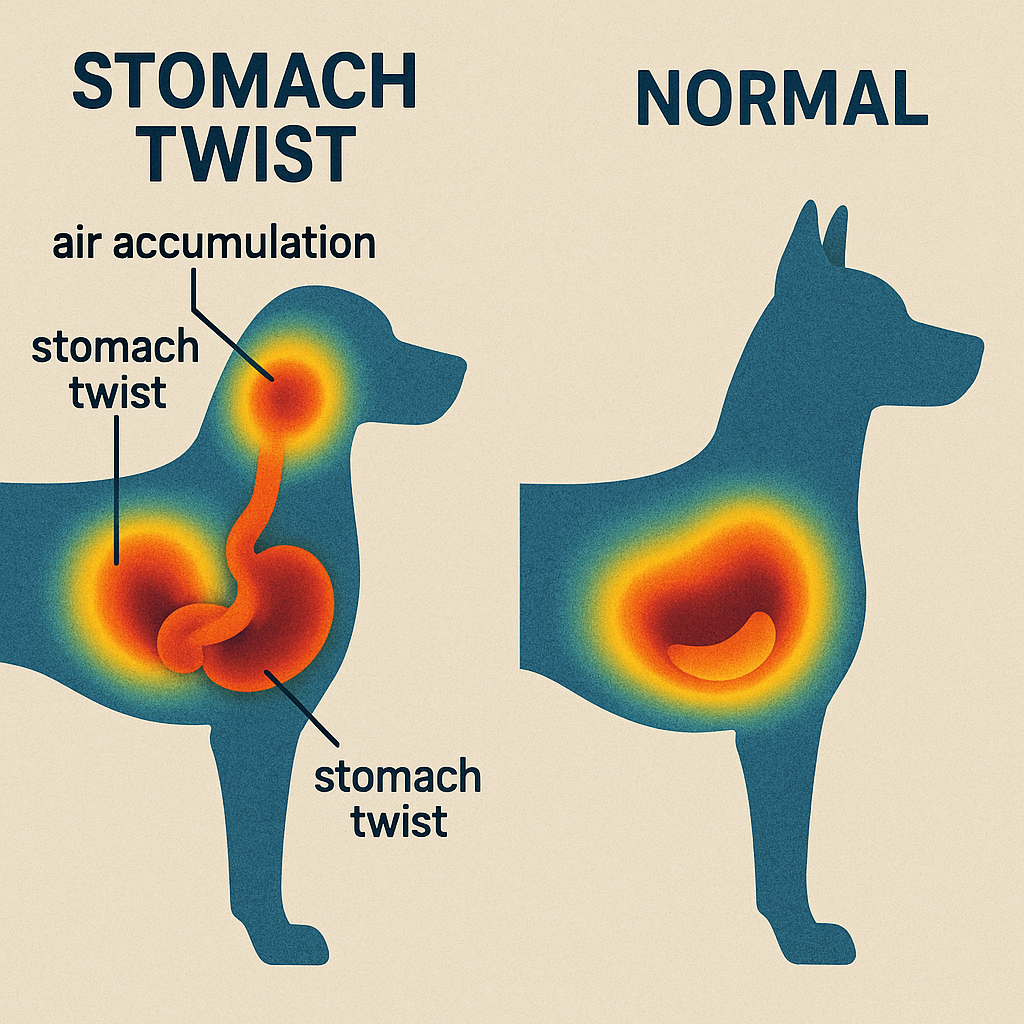
Gastric dilatation-volvulus (GDV), or bloat, is very dangerous for dogs. It happens when the stomach fills with gas, food, or liquid and twists. This twist blocks the esophagus, stopping food or air from moving. The swollen stomach pushes on other organs and slows blood flow to the heart. This can cause serious problems like shock or even death. Knowing what causes GDV can help keep your dog safe.
Symptoms and Warning Signs of Bloat
Spotting bloat early can save your dog’s life. Dogs with bloat may try to vomit but fail. They might seem anxious, restless, or stand hunched over. Their belly could look swollen and feel hard, like a drum. Other signs include pale gums, drooling a lot, and gagging without results. In bad cases, dogs might collapse or refuse to lie down. Here’s a table of common symptoms:
|
Symptom/Sign |
Description |
|---|---|
|
Tries to vomit |
Fails to vomit; happens every 5-30 minutes. |
|
Anxiety |
One of the first signs of bloat. |
|
Swollen belly |
Feels tight, like a drum. |
|
Pale gums |
Start dark red, turn white or blue later. |
|
Drooling a lot |
Heavy salivation is common. |
|
Fast heartbeat |
Heart rate speeds up as bloat worsens. |
If you see these signs, go to the vet right away. Quick action can stop the problem from getting worse.
Why Bloat Is a Serious Health Concern
Bloat is not just a stomach problem; it’s very dangerous. When the stomach twists, it cuts off blood flow to important organs. This can damage tissues and cause shock. Without fast treatment, bloat can kill a dog in hours. Dogs with bloat feel a lot of pain and discomfort. That’s why it’s one of the most serious emergencies for vets. By knowing the signs and acting fast, you can help protect your dog from this deadly condition.
Factors That Raise the Risk of Bloat
How Eating Too Fast Can Cause Bloat
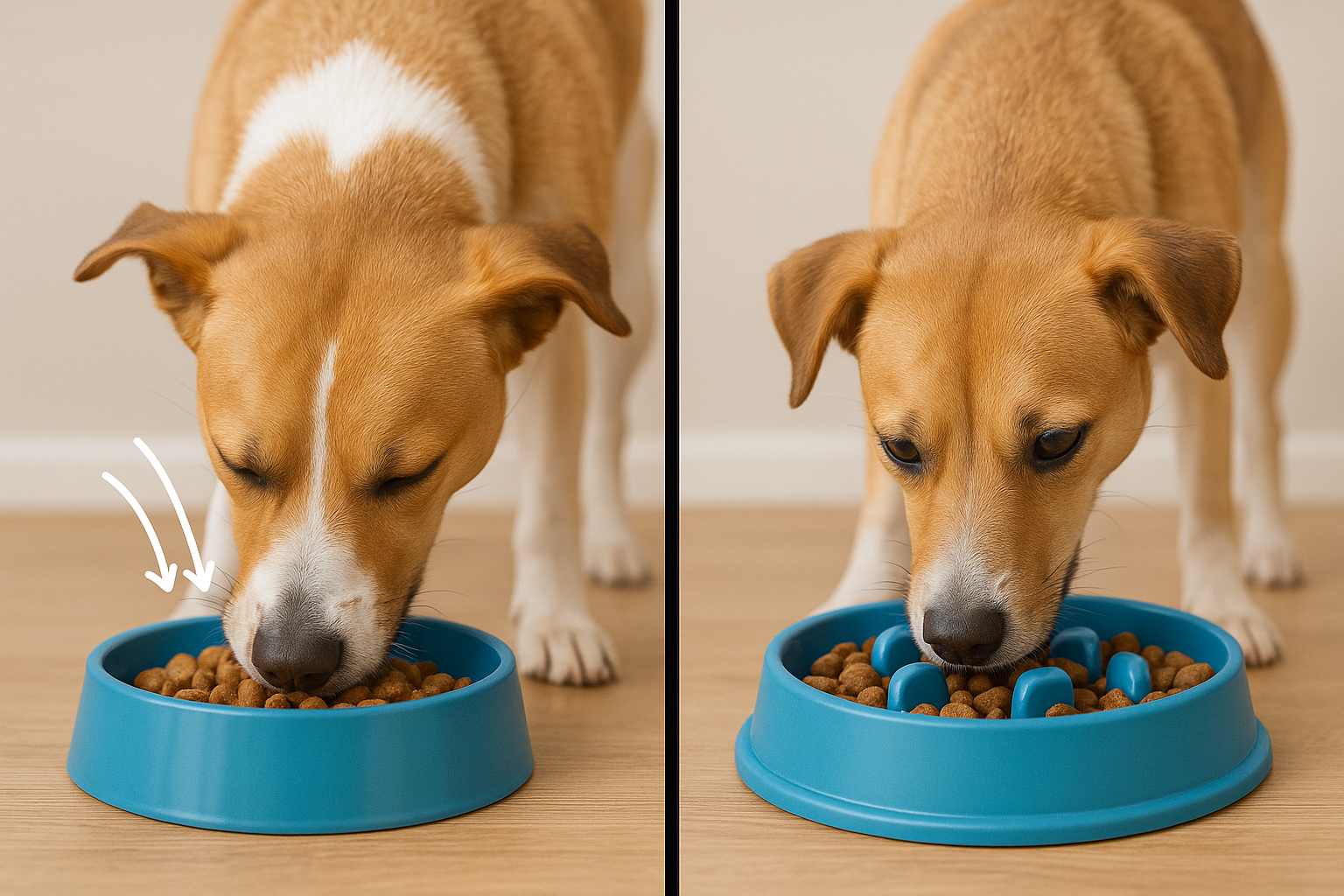
Eating too fast is a big reason dogs get bloat. When dogs eat quickly, they swallow too much air with their food. This extra air can make their stomach uncomfortable and increase the chance of GDV. Dogs that eat fast don’t chew well, which makes digestion harder. Eating slower helps the stomach process food better and lets air escape naturally. A slow feeder bowl is a great tool to help dogs eat slower.
Other Things That Can Lead to Bloat
Other factors can also make bloat more likely. Some breeds, like Great Danes and German Shepherds, are more at risk because of their body shape. Older dogs, especially around six years old, have a higher chance of bloat. Stress, like loud noises or changes in routine, can also increase the risk. Dogs that are nervous or aggressive may be more affected. You can lower these risks by keeping mealtime calm and watching your dog’s behavior.
Breeds Most Likely to Get Bloat
Certain breeds are more likely to get bloat because of their chest shape. Deep-chested dogs like Boxers, Weimaraners, and Standard Poodles are at higher risk. Large breeds like Saint Bernards and Irish Setters also have a greater chance of GDV. If you own one of these breeds, take steps to prevent bloat. Feed smaller meals, use a slow feeder bowl, and avoid exercise right after eating to keep your dog safe.
How Slow Feeder Dog Bowls Prevent Dog Bloat
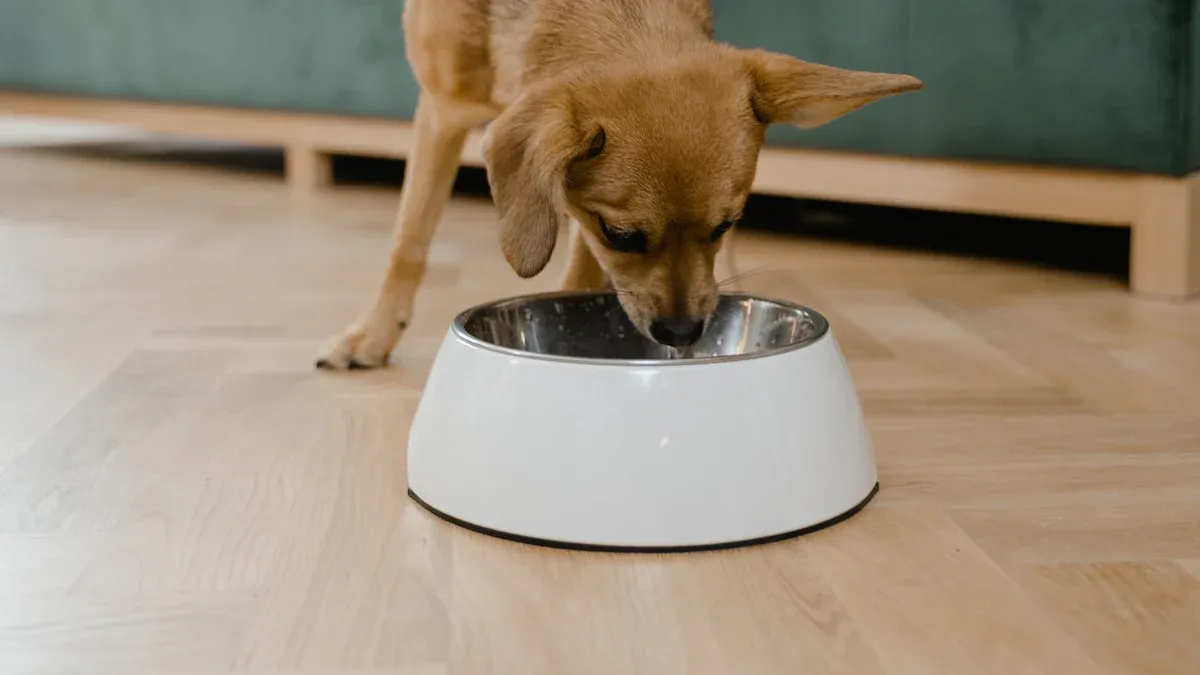
Slowing Down Eating to Reduce Air Swallowing
Dogs eating too fast often swallow too much air. This extra air can cause stomach problems and lead to bloat. Slow feeder bowls are made to help dogs eat slower. Eating slower means less air is swallowed, lowering the risk of bloat. These bowls make mealtime longer, helping dogs eat at a natural speed. This reduces the chances of gastric dilatation-volvulus (GDV).
Research shows slow feeders make dogs take up to ten times longer to eat. This extra time helps prevent choking and throwing up. For instance, the Ceramic Single/Double Cat Bowl with Bamboo Stand has a spiral inside. This design slows eating, reducing bloat and choking risks. It also looks stylish in your pet’s feeding area.
Encouraging Proper Chewing and Digestion
Chewing food well is important for good digestion. Dogs eating too fast may swallow big pieces without chewing. This can cause stomach problems like vomiting or indigestion. Slow feeder bowls make dogs chew their food better. Chewing breaks food into smaller pieces, making digestion easier.
The Frenchie Companion Pet Bowl is great for flat-faced dogs like Pugs. Its tilted design helps dogs eat in a natural position. This makes chewing easier and supports better digestion. Eating slower with this bowl also lowers the chance of bloat. Its wide opening and non-slip base make mealtime stable and comfortable.

Mimicking Natural Foraging Behavior
Dogs naturally like to search for food. In the wild, they spend time finding and working for meals. Slow feeder bowls copy this behavior by adding obstacles to eating. This slows them down and keeps them mentally active during meals.

The Elevated Ice Cream Design Puppy Bowl is fun and useful. Its swirl ridges slow eating, while the raised design helps with posture. This bowl is ideal for puppies and small dogs. It helps them eat slower, preventing bloat and teaching healthy habits. Its playful look and strong materials make it a great choice for pets.
Using slow feeder bowls helps dogs eat slower, chew better, and enjoy meals more. These bowls prevent bloat and improve digestion, keeping your dog healthier overall.
Benefits of Using a Slow Feeder Dog Bowl
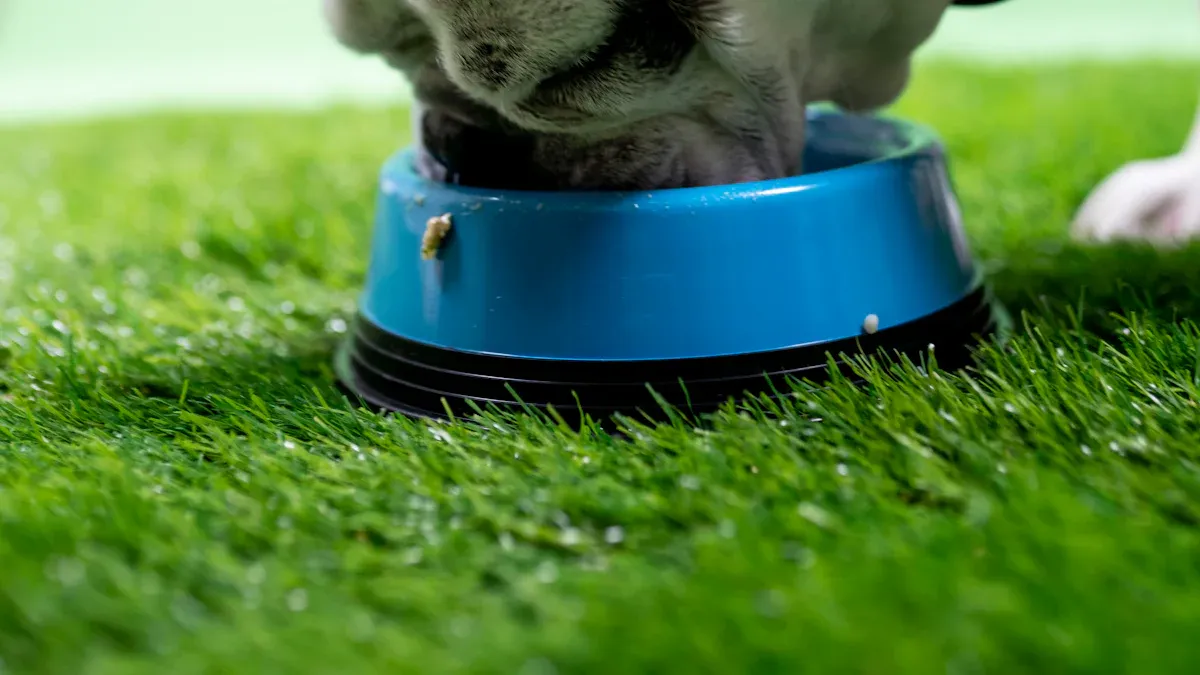
Lowering the Risk of Bloat and Stomach Problems
A slow feeder bowl helps lower the chance of bloat. Eating too fast makes dogs swallow extra air with their food. This trapped air can cause pain or serious stomach issues like GDV. Slowing down eating reduces air intake and helps digestion work better.

For instance, the Ceramic Single Double Cat Bowl with Bamboo Stand has a spiral inside. This design slows eating, cutting down on air swallowing and choking. Its bamboo stand keeps the bowl steady, making mealtime safe and calm for your dog.
Helping Dogs Absorb Nutrients Better
Eating slower also helps dogs get more nutrients from food. Chewing breaks food into smaller pieces, making it easier to digest. Good digestion helps dogs absorb nutrients, keeping them healthy and full of energy.

The Frenchie Companion Pet Bowl is perfect for flat-faced dogs like Pugs. Its tilted shape helps dogs eat in a natural position. This slows eating and improves digestion, helping dogs get the most from their meals.
Making Mealtime Fun and Stimulating
Slow feeder bowls also keep dogs mentally active during meals. Their designs mimic searching for food, making eating more fun. This can reduce boredom and stress, especially for dogs eating alone.

The Elevated Ice Cream Design Puppy Bowl is both playful and useful. Its ridges slow eating while giving dogs a fun challenge. The raised design helps posture, making it great for puppies and small dogs. This bowl prevents overeating and keeps dogs entertained during meals.
Using a slow feeder bowl helps digestion, lowers bloat risk, and keeps dogs engaged. These benefits lead to a healthier, happier dog and a calmer mealtime for you.
Helping Dogs Eat Healthier Every Day
Good eating habits are important for your dog’s health. Slow feeder bowls help fix problems like overeating, eating too fast, and bad digestion. These bowls work for all dogs, whether small, flat-faced, or large breeds. They make mealtime healthier and safer.
Stopping Overeating and Weight Gain
Overeating can make dogs gain too much weight. About 56% of U.S. dogs are overweight or obese. This shows why portion control and slower eating matter. Slow feeder bowls make meals last longer. This gives your dog’s brain time to feel full. It helps stop overeating and keeps their weight healthy.
Tip: Use a slow feeder bowl with measured portions of good-quality dog food to help control weight.
Lowering Digestive Problems
Eating too fast can cause vomiting, upset stomachs, or even bloat. Studies show fast eating is linked to these problems. Slow feeder bowls slow down eating, which lowers these risks. They also make dogs chew better, helping digestion and nutrient absorption.
For instance, the Frenchie Companion Pet Bowl helps flat-faced dogs eat naturally. Its tilted shape slows eating and improves digestion. It’s a great choice for dogs with sensitive stomachs.
Making Mealtime Fun for All Dogs
Dogs of all breeds and sizes enjoy mindful eating. Slow feeder bowls copy natural foraging, turning meals into fun challenges. This keeps dogs busy and less bored. For small dogs and puppies, the Elevated Ice Cream Design Puppy Bowl is perfect. Its ridges slow eating, and its raised design helps posture and digestion.
Note: Dogs that eat slower often develop better eating habits, avoiding future health problems.
Creating Healthy Routines for Life
Regular use of a slow feeder bowl helps dogs eat slower over time. This builds a healthy routine and improves their relationship with food. It also makes meals more enjoyable for both you and your dog.
Adding a slow feeder bowl to your dog’s daily life prevents health risks like bloat. It also promotes long-term health and happiness. Whether you pick a stylish ceramic bowl or a playful raised design, slow feeding benefits all dogs, no matter their age or breed.
Choosing the Right Slow Feeder Dog Bowl
Key Factors to Consider (e.g., Size, Material, and Design)
Picking the right slow feeder bowl means thinking about size, material, and design. These factors help keep your dog safe and comfy while eating.
|
Factor |
Description |
|---|---|
|
Material |
Hard materials like stainless steel or ceramic might harm teeth if chewed too hard. |
|
Design |
Complicated designs can upset dogs and make eating harder. |
|
Eating Behavior |
Slow feeder bowls improve digestion and portion control, lowering risks like choking or bloat. |
For instance, the Ceramic Single/Double Cat Bowl with Bamboo Stand is made of lead-free ceramic, which is safe and simple to clean. Its spiral shape slows eating, helping prevent choking and bloat. The bamboo stand keeps the bowl steady, stopping spills and making meals easier.
Choose a bowl material that fits your dog’s eating habits. Dogs that chew a lot may do better with softer materials like silicone-lined bowls. Bowls with simple patterns, like swirls or ridges, are good for most dogs and won’t frustrate them.
Matching the Bowl to Your Dog’s Breed and Eating Style
Your dog’s breed and how they eat decide the best slow feeder bowl. Big dogs need larger bowls, while small dogs need smaller ones.
-
Pick a bowl size that matches your dog’s meal portions. This stops food from piling up and keeps the slow feeding effective.
-
Bowl features like ridges or spirals slow eating and keep dogs mentally engaged.
-
Flat-faced dogs, like Pugs or French Bulldogs, need shallow ridges and tilted bowls. The Frenchie Companion Pet Bowl has a 30-degree tilt, helping dogs eat naturally and avoid neck strain.
-
Dogs with long noses may prefer deeper bowls with more detailed designs to challenge their eating pace.
For puppies or small dogs, the Elevated Ice Cream Design Puppy Bowl is a fun and useful choice. Its raised design aids digestion, and its swirl ridges slow eating well.
Maintenance Tips for Long-Lasting Use
Taking care of your slow feeder bowl helps it last longer and stay safe for your dog.
-
Clean Often: Wash the bowl after every meal to stop bacteria from growing. Dishwasher-safe bowls, like the Ceramic Single/Double Cat Bowl, make cleaning easy.
-
Check for Damage: Look for cracks or wear, especially in ceramic or plastic bowls. Replace damaged bowls to keep your dog safe.
-
Store Properly: Keep the bowl in a dry spot to avoid mold or bad smells. Raised bowls, like the Ice Cream Puppy Bowl, stay clean and steady on their wooden legs.
-
Use the Right Cleaner: Wash silicone-lined bowls with mild soap and avoid harsh cleaners on ceramic bowls.
By taking care of the bowl, you make sure your dog has safe and healthy meals every day.
A slow feeder dog bowl is great for your dog’s health. It makes dogs eat slower, lowering the chance of gulping food. This helps stop bloat and reduces choking or throwing up. Slow eating also improves digestion and controls your dog’s weight. Vets say these bowls help prevent obesity and boost health. Picking the right bowl keeps your dog safe and happy. It makes meals fun and healthier for your furry friend.
FAQ
What is the best way to introduce a slow feeder bowl to your dog?
Start by adding a small amount of food to the slow feeder bowl. Let your dog explore it at their own pace. If they seem hesitant, encourage them with positive reinforcement, like praise or treats. Gradually increase the amount of food as they get comfortable.
Can slow feeder bowls work for all dog breeds?
Yes, slow feeder bowls suit all breeds. However, you should choose a design that matches your dog’s size and eating style. For example, flat-faced breeds benefit from tilted bowls, while larger breeds may need deeper bowls with intricate patterns to slow their eating.
How often should you clean a slow feeder bowl?
You should clean the bowl after every meal. This prevents bacteria buildup and keeps your dog’s food safe. Dishwasher-safe bowls, like the Ceramic Single/Double Cat Bowl, make cleaning easier. Always check for cracks or damage during cleaning to ensure the bowl remains safe for use.
Do slow feeder bowls help with weight management?
Yes, they can. Slow feeder bowls extend mealtime, giving your dog’s brain time to register fullness. This helps prevent overeating and supports healthy weight management. Pair the bowl with portion control and high-quality dog food for the best results.
Are slow feeder bowls safe for puppies?
Absolutely! Slow feeder bowls, like the Elevated Ice Cream Design Puppy Bowl, are ideal for puppies. They help young dogs develop healthy eating habits by slowing their pace and improving digestion. The raised design also supports better posture, making mealtime safer and more comfortable for growing pups.
See Also
Gabby Whale's Elevated Ceramic Bowls Improve Pet Digestion Significantly
Comparing Bear Pet Bowls and Classic Dog Bowls for Pets
Five Best Gabby Whale Cat Bowls for Contented Felines
Five Benefits of Using Ceramic Bowls for Your Cats
Gabby Whale's Interactive Dog Toy Reduces Canine Boredom Effectively








